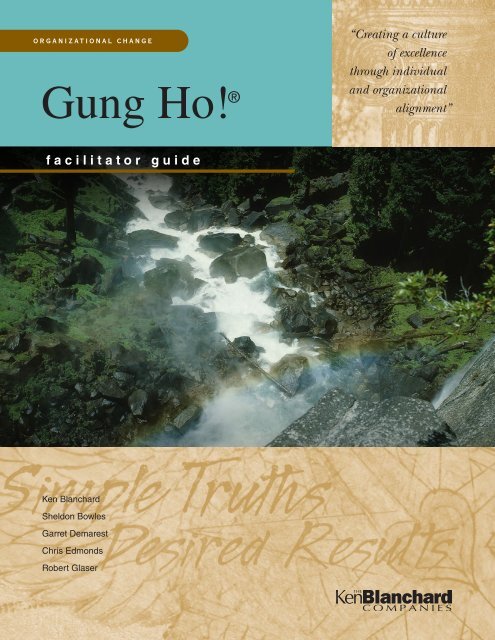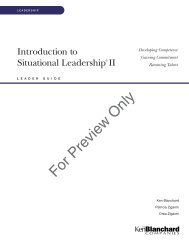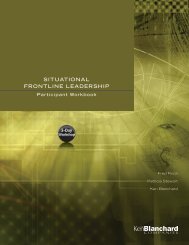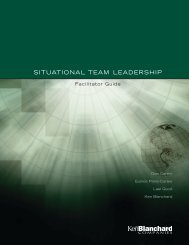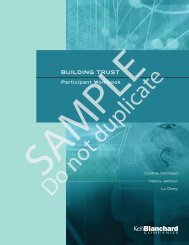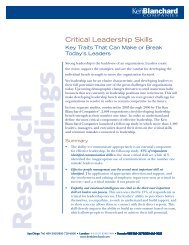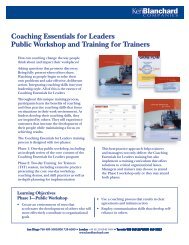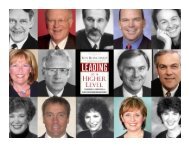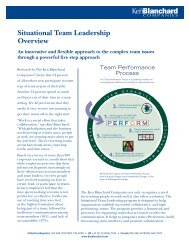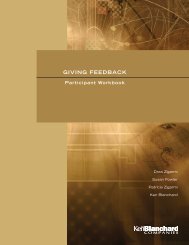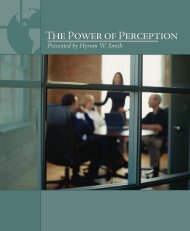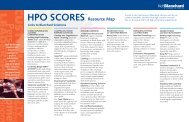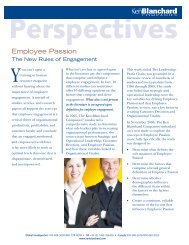Gung Ho!® - Ken Blanchard
Gung Ho!® - Ken Blanchard
Gung Ho!® - Ken Blanchard
- No tags were found...
Create successful ePaper yourself
Turn your PDF publications into a flip-book with our unique Google optimized e-Paper software.
ORGANIZATIONAL CHANGE<strong>Gung</strong> <strong>Ho</strong>! ®“Creating a cultureof excellencethrough individualand organizationalalignment”facilitator guide<strong>Ken</strong> <strong>Blanchard</strong>Sheldon BowlesGarret DemarestChris EdmondsRobert Glaser
AUTHORSKEN BLANCHARDSHELDON BOWLESGARRET DEMARESTCHRIS EDMONDSROBERT GLASEREDITORROBERT BRILLANTESPROJECT MANAGERSROBERT BRILLANTESKIM KINGPRODUCTION COORDINATORNINA THOMPSONLAYOUT AND DESIGNCARLA DEBOSETARA WALLACECHRIS EDMONDS© Copyright 2000 by The <strong>Ken</strong> <strong>Blanchard</strong> Companies ® . All rights reserved. Do not duplicate.These materials have been designed to develop specific knowledge and skills and have been thoroughlytested to ensure their effectiveness. They represent the proprietary intellectual property of The <strong>Ken</strong> <strong>Blanchard</strong>Companies and are protected under international copyright law. These materials may not be reproduced inwhole or in part in any form without the prior written permission of The <strong>Ken</strong> <strong>Blanchard</strong> Companies.Global Headquarters USA 760 489-5005 • 800 728-6000 • Fax 760 489-8407UK +44 (0) 1483 456300 Canada 905 829-3510 • 800 665-5023 Singapore +65 6775 1030www.kenblanchard.comItem # 10831V053102
GUNG HO! ®FACILITATOR GUIDETable of ContentsTraining PreparationWorkshop Overview .............................................................. TP–1Workshop Facilitation ............................................................ TP–2Facilitator Guide .................................................................... TP–4Workshop Materials ............................................................... TP–6Basic Equipment and Supplies ............................................... TP–7Learning Environment ............................................................ TP–8Prework ................................................................................. TP–9<strong>Gung</strong> <strong>Ho</strong>! ® Quotient Profile ................................................... TP–10Facilitator Guide Pages........................................................... TP–11Training Design (2 Days) ........................................................ TP–12Intact Team Training Design ................................................... TP–15Pretraining Checklist .............................................................. TP–17Introduction1<strong>Gung</strong> <strong>Ho</strong>! ® , Friend ................................................................... 1–1Introduction Interviews ............................................................ 1–2Introduce Participants .............................................................. 1–3Workshop Overview ................................................................ 1–5Creating a Learning Community and Community Norms ......... 1–11<strong>Gung</strong> <strong>Ho</strong>! Award for Business Excellence ................................ 1–14Visionary Companies ............................................................... 1–18Corporate Culture .................................................................... 1–20A Case for <strong>Gung</strong> <strong>Ho</strong>! ............................................................... 1–22Participant Workbook PagesPurpose and Values2Purpose and Values .................................................................. 2–1Purpose and Values .................................................................. 2–2Clarifying Your Personal Purpose and Values ............................ 2–3Purpose and Values Poster ....................................................... 2–5Personal and Organizational Alignment ................................... 2–8Alignment Check ..................................................................... 2–12Who Are You? Video ................................................................ 2–14<strong>Gung</strong> <strong>Ho</strong>!® Dramatic Video—Introduction ............................... 2–16Case Study: Walton Works #2 Finishing Department ................ 2–17<strong>Gung</strong> <strong>Ho</strong>! Quotient Profile ...................................................... 2–23Tools and Resources ................................................................ 2–29Action Planning ....................................................................... 2–30Conclude Purpose and Values Module ..................................... 2–32Participant Workbook Pages© 2000 The <strong>Ken</strong> <strong>Blanchard</strong> Companies. All rights reserved. Do not duplicate • V053102 FACILITATOR iii
FACILITATOR GUIDE GUNG HO! ®Table of ContentsSpirit of the Squirrel3Spirit of the Squirrel ................................................................. 3–1Principle 1—Spirit of the Squirrel ............................................. 3–2Case Study: Fast-Food Restaurant ............................................. 3–4Critical Job Functions ............................................................... 3–7SMART Goals .......................................................................... 3–9Your SMART Goal .................................................................... 3–12Accountability for Values ......................................................... 3–14Performance-Values Matrix ...................................................... 3–17Fish! ® Video .............................................................................. 3–24Analyzing the GHQ ................................................................. 3–25Tools and Resources ................................................................ 3–27Action Planning ....................................................................... 3–28Conclude Spirit of the Squirrel ................................................. 3–30Participant Workbook PagesWay of the Beaver4Way of the Beaver .................................................................... 4–1Day One Review: Cognitive Walk ............................................ 4–2Principle 2—Way of the Beaver ............................................... 4–5Transitions ............................................................................... 4–7Case Study: Transition Plan ...................................................... 4–9Leadership Behaviors Needed for Peak Performance ................ 4–12Win as Much as You Can ......................................................... 4–16Trust in Your Team .................................................................... 4–21Systems Analysis ...................................................................... 4–22System Analysis of Your Work Team ......................................... 4–26Analyzing the GHQ ................................................................. 4–28Tools and Resources ................................................................ 4–30Action Planning ....................................................................... 4–31Conclude Way of the Beaver .................................................... 4–32Participant Workbook Pagesiv FACILITATOR © 2000 The <strong>Ken</strong> <strong>Blanchard</strong> Companies. All rights reserved. Do not duplicate • V053102
GUNG HO! ®FACILITATOR GUIDETable of ContentsGift of the Goose5Gift of the Goose ..................................................................... 5–1Principle 3—Gift of the Goose ................................................. 5–2Congratulations Must Be TRUE ................................................ 5–4No Score, No Game, Cheer the Progress ................................ 5–9(Pen-Toss Option) .................................................................. 5–12(Sid Video Option) ................................................................. 5–19E = mc 2 ................................................................................... 5–22Storytelling .............................................................................. 5–24Analyzing the GHQ ................................................................. 5–26Tools and Resources ................................................................ 5–28Action Planning ....................................................................... 5–29Conclude Gift of the Goose ..................................................... 5–30Participant Workbook PagesCreating a Plan for Change6Creating a Plan for Change ...................................................... 6–1Creating a Plan for Change ...................................................... 6–2Bringing It All Together ............................................................. 6–3Action Plan Worksheet ............................................................ 6–5Workshop Evaluations ............................................................. 6–7Celebration of Key Learnings ................................................... 6–9Participant Workbook PagesAppendixDescription of <strong>Gung</strong> <strong>Ho</strong>! ® Animals .......................................... A–1Participant Workbook Appendix© 2000 The <strong>Ken</strong> <strong>Blanchard</strong> Companies. All rights reserved. Do not duplicate • V053102 FACILITATOR v
Training Preparation gung <strong>Ho</strong>! ®Training Design (2 Days)Prework<strong>Gung</strong> <strong>Ho</strong>! hardback book, Prework Booklet, and GHQ for participant and team members (optional).Day 1timeRunning Time1—Introduction 1 hr 55 min 1 hr 55 min8:20 Introduction Interviews (as participants arrive) :108:30 Introductions :208:50 Workshop Overview :109:00 Creating a Learning Community and Community Norms :159:15 <strong>Gung</strong> <strong>Ho</strong>! Award for Business Excellence :259:40 Break :109:50 Visionary Companies :1510:05 Corporate Culture :0510:10 A Case for <strong>Gung</strong> <strong>Ho</strong>! :052—Purpose and Values 4 hr 18 min 6 hr 13 min10:15 Purpose and Values :0210:17 Clarifying Your Personal Purpose and Values :0510:22 Purpose and Values Poster :4511:07 Break :1011:17 Personal and Organizational Alignment :1511:32 Alignment Check :0511:37 Who Are You? Video (option) :1511:52 <strong>Gung</strong> <strong>Ho</strong>!® Dramatic Video—Introduction :0812:00 Lunch :601:00 Case Study: Walton Works #2 Finishing Department :451:45 <strong>Gung</strong> <strong>Ho</strong>! Profile/Tools and Resources :222:07 Action Planning :152:22 Conclude Purpose and Values :012:23 Break :10TP–12 FACILITATOR© 2000 The <strong>Ken</strong> <strong>Blanchard</strong> Companies. All rights reserved. Do not duplicate • V053102
gung ho! ®training preparationTraining Design (2 Days)Day 1 (continued)timeRunning Time3—Spirit of the Squirrel 2 hr 27 min 8 hr 40 min2:33 Principle 1—Spirit of the Squirrel :122:45 Case Study: Fast Food Restaurant :303:15 Critical Job Functions :103:25 SMART Goals :043:29 Your SMART Goal :103:39 Accountability for Values :133:52 Performance-Values Matrix :154:07 Fish! Video Option :254:32 Analyzing the GHQ/Tools and Resources :124:44 Action Planning :154:59 Conclude Spirit of the Squirrel :01Day 24—Way of the Beaver 4 hr 43 min 4 hr 43 min8:30 Day One Review: Cognitive Walk :258:55 Principle 2—Way of the Beaver :109:05 Transitions :159:20 Case Study: Transition Plan :159:35 Break :109:45 Leadership Behaviors Needed forPeak Performance :3510:20 Win as Much as You Can :4011:00 Trust in Your Team :0511:05 Break :1011:15 Systems Analysis :2011:35 Systems Analysis of Your Work Team :1011:45 Analyzing the GHQ/Tools and Resources :1211:57 Action Planning :1512:12 Conclude Way of the Beaver :0112:13 Lunch :60© 2000 The <strong>Ken</strong> <strong>Blanchard</strong> Companies. All rights reserved. Do not duplicate • V053102 FACILITATOR TP–13
Training Preparation gung <strong>Ho</strong>! ®Training Design (2 Days)Day 2 (continued)timeRunning Time5—Gift of the Goose 2 hr 8 min 6 hr 51 min1:13 Principle 3—Gift of the Goose :101:23 Congratulations Must Be TRUE :05–151:38 No Game, No Score, Cheer the Progress :051:43 Pen-Toss Option or Sid Video Option :252:08 E = mc 2 :102:18 Break :102:28 Storytelling :252:53 Analyzing the GHQ/Tools and Resources :123:05 Action Planning :153:20 Conclude Gift of the Goose :016—Creating a Plan for Change 1 hr 44 min 8 hr 35 min3:21 Creating a Plan for Change :093:30 Bringing It All Together :153:45 Action Plan Worksheet :204:05 Break :104:15 Workshop Evaluations :104:25 Celebration of Key Learnings :304:55 Workshop Closing :10TP–14 FACILITATOR© 2000 The <strong>Ken</strong> <strong>Blanchard</strong> Companies. All rights reserved. Do not duplicate • V053102
gung ho! ® Introduction 1<strong>Gung</strong> <strong>Ho</strong>!®, FriendWorkshop OverviewThe <strong>Gung</strong> <strong>Ho</strong>! ® workshop is based on the best-selling book by <strong>Ken</strong> <strong>Blanchard</strong> and Sheldon Bowles. Theworkshop’s purpose is to create a learning experience that provides leaders with the knowledge, skills, andmotivation to build a <strong>Gung</strong> <strong>Ho</strong>! organization. This highly interactive workshop will help you put <strong>Gung</strong> <strong>Ho</strong>! principlesto work—for you, your work teams, your organization, your family, and your community.Workshop Objectives• To learn the elements of the three <strong>Gung</strong> <strong>Ho</strong>! principles• To discover your team’s <strong>Gung</strong> <strong>Ho</strong>! ® Quotient (an assessment tool to identify and analyze gaps between yourteam’s and organization’s current reality and best practices)• To clarify your personal purpose and values and to explore how these align with your organization’s purposeand values• To understand how to develop team members and transfer control for achieving goals into their hands• To provide praise and encouragement linked to declared goals and tailored to the uniqueness of each teammember• To begin to learn how to build a corporate culture that improves the quality of life for employees and customers• To develop an action plan based on the progressive completion of the three principles for making <strong>Gung</strong> <strong>Ho</strong>! areality—within your sphere of influence in your organization and beyondIntroduction1hr 45minActivity Page Time Running TimeIntroduction Interviews (as participants arrive) 1–2 :10 :10Introductions 1–3 :20 :30Workshop Overview 1–5 :10 :40Creating a Learning Communityand Community Norms 1–11 :15 :55<strong>Gung</strong> <strong>Ho</strong>! Award for Business Excellence 1–14 :25 1:20Visionary Companies 1–18 :15 1:35Corporate Culture 1–20 :05 1:40A Case for <strong>Gung</strong> <strong>Ho</strong>! 1–22 :05 1:45© 2000 The <strong>Ken</strong> <strong>Blanchard</strong> Companies. All rights reserved. Do not duplicate • V053102 FACILITATOR 1–
1 Introduction gung ho! ®Introduction Interviews :10Provides an icebreaker for participants and creates an optimal learningenvironmentPrior to the Start of the Workshop1–11. Display visual aid 1–1—<strong>Gung</strong> <strong>Ho</strong>!Set Up Participant Interviews ... Pairs :101–21. Display the prepared flip chart or visual aid 1–2—IntroductionInterviews.Pair up with a workshop participant you do notknow and share the following information:• Your name and organization*• Your role and number of direct reports*• Which <strong>Gung</strong> <strong>Ho</strong>! character do you mostidentify with?• Which <strong>Gung</strong> <strong>Ho</strong>! principle are you mostinterested in learning?• What would you like to take away from thisworkshop?• Describe something unique about yourself.2. As participants arrive, ask them to interview someone they donot know, using the questions on the flip chart. Tell them theywill be using the answers to these questions in an exercise, sothey should take written notes while interviewing their partner.3. After everyone has been interviewed, ask participants to findtheir seats.* Omit these questions for intact work groups.1– FACILITATOR © 2000 The <strong>Ken</strong> <strong>Blanchard</strong> Companies. All rights reserved. Do not duplicate • V053102
gung ho! ® Introduction 1Introductions :20Introduces facilitators and participants.r e f e r e n c eOptionalEngage participants in chant.Lead the following cheer:Give me a GGive me a UGive me an NGive me a GGive me an HGive me an OWhat’s that spell?! I can’t hearyou! One more time!Introduce Facilitators ... Large Group :031. Welcome the participants to the workshop.2. Introduce yourself (and cofacilitator, if appropriate).Set Up Participant Introductions :011. Give these directions ...All of us are going to spend some time togetherover the next two days, so it’s important that weget to know each other.Please take out your notes about the personyou interviewed this morning. I would like youto introduce your partner by sharing his or herresponses to the questions on the flip chart.Which pair would like to go first?Conduct Participant Introductions ... Large Group :15Late arrivals can introduce themselves by answering thequestions.© 2000 The <strong>Ken</strong> <strong>Blanchard</strong> Companies. All rights reserved. Do not duplicate • V053102 FACILITATOR 1–
1 Introduction gung ho! ®IntroductionsConclude Introductions ... Large Group :011. Make this remark ...The people in this room are an important part ofyour learning experience. The goal is to help eachother acquire the knowledge and skills taught inthis workshop. Everything that happens in thisworkshop is a learning opportunity. I want you totake the time to get to know each other in orderto optimize your learning experience!1– FACILITATOR © 2000 The <strong>Ken</strong> <strong>Blanchard</strong> Companies. All rights reserved. Do not duplicate • V053102
gung ho! ® Introduction 1Workshop Overview :10Provides an overview of the workshop and presents workbook materialsr e f e r e n c e<strong>Gung</strong> <strong>Ho</strong>! Organizations• Merck Corporation• ASDA• Sun Chemical• Parker-HannafinIntroduce Workshop ... Large Group :021. Briefly introduce the topic of <strong>Gung</strong> <strong>Ho</strong>!Examples*• Your examples of <strong>Gung</strong> <strong>Ho</strong>! organizations• Participants’ examples of <strong>Gung</strong> <strong>Ho</strong>! organizations• Specific needs of the group• Current stories about <strong>Gung</strong> <strong>Ho</strong>! organizations• <strong>Ho</strong>w participants learned about <strong>Gung</strong> <strong>Ho</strong>!Introduce Workbook Materials :011. Confirm that every participant has the following:• Participant Workbook• Process Map• Leader Behavior Cards* Additional examples can be found in the Tools and Resources pages in theparticipant workbook at the end of each module.© 2000 The <strong>Ken</strong> <strong>Blanchard</strong> Companies. All rights reserved. Do not duplicate • V053102 FACILITATOR 1–
1 Introduction gung ho! ®Workshop OverviewDescribe Workshop ... Large Group :021. Refer to workbook page 1–1—<strong>Gung</strong> <strong>Ho</strong>!, Friend.1–31–42. Display visual aids 1–3 and 1–4—<strong>Gung</strong> <strong>Ho</strong>! Outcomes.3. Briefly review workshop overview and objectives.4. Refer to workbook pages 1–2 and 1–3—<strong>Gung</strong> <strong>Ho</strong>! ® RoadMap.5. Make these remarks ...This road map represents what we’re going tocover over the next couple of days.First, we’re going to give you an overview ofthe workshop and ask for your commitment tobeing a participant in the next two days. We’llalso explore reasons to <strong>Gung</strong> <strong>Ho</strong>! your sphere ofinfluence by looking at visionary companies andcorporate culture.Then, we’ll explore your personal purpose andvalues and your organization’s purpose andvalues and see if they’re in alignment.We’ll then look at the first principle of<strong>Gung</strong> <strong>Ho</strong>!—Spirit of the Squirrel—and discoverways to make this principle come alive in yoursphere of influence through finding meaning inyour work.1– FACILITATOR © 2000 The <strong>Ken</strong> <strong>Blanchard</strong> Companies. All rights reserved. Do not duplicate • V053102
gung ho! ® Introduction 1Workshop OverviewOn the second day, we’ll discover ways forimplementing the second <strong>Gung</strong> <strong>Ho</strong>! principle—Way of the Beaver—by looking at how we candevelop our team members to take charge ofachieving their own goals. Then, we’ll move onto the third principle—Gift of the Goose, which isabout cheering each other on.Finally, we’ll bring it all together by creating anaction plan for you to <strong>Gung</strong> <strong>Ho</strong>! your sphere ofinfluence. This action plan will be the culminationof all that you will have learned from our two daystogether and will solidify your commitment to usewhat you will learn.This workshop is going to be an excitingbeginning to the journey of becoming a <strong>Gung</strong> <strong>Ho</strong>!organization.© 2000 The <strong>Ken</strong> <strong>Blanchard</strong> Companies. All rights reserved. Do not duplicate • V053102 FACILITATOR 1–
1 Introduction gung ho! ®Workshop Overviewr e f e r e n c eSet Up <strong>Gung</strong> <strong>Ho</strong>!® Process Map ... Large Group :021. Refer to <strong>Gung</strong> <strong>Ho</strong>! Process Map.1–52. Display visual aid 1–5—<strong>Gung</strong> <strong>Ho</strong>! Process Map.3. Make these points ...The <strong>Gung</strong> <strong>Ho</strong>! Process Map is a tool for you tocapture your <strong>Gung</strong> <strong>Ho</strong>! key learnings. As weget to each of the sections, such as Purpose andValues, you can write in what your key learningsare for that section.You can use words, pictures, or symbols that willhelp you capture and remember what you’velearned.After we’ve completed the workshop, thismap will contain important notes about eachstep of the journey to becoming a <strong>Gung</strong> <strong>Ho</strong>!organization.We hope that you will post this map to remindyou of your journey and to provide you withdirection and encouragement when you need it.1– FACILITATOR © 2000 The <strong>Ken</strong> <strong>Blanchard</strong> Companies. All rights reserved. Do not duplicate • V053102
gung ho! ® Introduction 1Workshop OverviewSet Up Ideas, Insights, and Intentions Page ... Large Group :011. Refer to workbook appendix page A–11—Ideas, Insights, andIntentions.2. Make these points ...The Ideas, Insights, and Intentions page is aplace for you to capture any “ahas,” significantlearnings, interesting facts, or action items.As we move through the workshop, a thoughtmay come to you, or someone might make asuggestion, or your group may have a brainstormof excellent ideas. Use this page to quicklycapture some notes about your thoughts.You can later transfer some of these notes to yourProcess Map or use them for the action plan thatyou will create.© 2000 The <strong>Ken</strong> <strong>Blanchard</strong> Companies. All rights reserved. Do not duplicate • V053102 FACILITATOR 1–
1 Introduction gung ho! ®Workshop Overviewr e f e r e n c e“I can’t understand why peopleare frightened by new ideas. I’mfrightened of old ones.”—John Cage1–6Review John Cage Quote ... Large Group :021. Display visual aid 1–6—”I can’t understand ...”2. Read quote from John Cage.3. Make these points ...John Cage was a Grammy award-winningcomposer with much wisdom. This quote reallyspeaks about change.You are going to be exposed to a number of newideas and maybe even a different philosophy inthe way you manage people, the way you planperformance, the way you create an environmentfor people that work with you, and the way youprovide service.This workshop is about culture change. Movingtoward <strong>Gung</strong> <strong>Ho</strong>! is not an easy proposition. It’svery likely that you will have to let go of some ofthe behaviors, systems, policies, and your habitualways of managing.Unfortunately, some organizations are often socommitted to their systems that they get in theway of an organizational culture shift.It’s going to take a strong commitment on yourpart. You need to make a commitment to create apocket of excellence within your organization.1–10 FACILITATOR © 2000 The <strong>Ken</strong> <strong>Blanchard</strong> Companies. All rights reserved. Do not duplicate • V053102
gung ho! ® Introduction 1Creating a Learning Community and :15Community NormsCreates an optimal learning environment for the workshop and models teambuilding processesIntroduce Creating a Learning Community ... Large Group :011. Refer to workbook page 1–4—Creating a LearningCommunity.2. Make these remarks ...We believe we are all here as a community oflearners to learn about <strong>Gung</strong> <strong>Ho</strong>! and how tochange your sphere of influence.To ensure that we maintain this sense ofcommunity, we need to agree on some norms andground rules regarding how we, as a group, willbehave during the workshop.1–73. Display visual aid 1–7—Community Norms—and review thedefinition of norms.© 2000 The <strong>Ken</strong> <strong>Blanchard</strong> Companies. All rights reserved. Do not duplicate • V053102 FACILITATOR 1–11
1 Introduction gung ho! ®Creating a Learning Community and Community Normsr e f e r e n c eSample Norms• Assume best intentions.• Seek to understand beforebeing understood.• Be a participant.• Focus on the topic at hand.• Keep commitments.• Be on time.• One person speaks at a time.• Be candid.• Seek cooperative effort.• Be problem solvers, notproblem spotters.• <strong>Ho</strong>nor confidentiality.Set Up List of Norms ... Teams :011. Refer to workbook pages 1–4—Creating a LearningCommunity and 1–5—Community Norms.2. Give these directions ...In your teams, we would like you to list five tosix norms that you agree to commit to during theworkshop. Write your final list of norms onpage 1–5.There are some sample norms on page 1–4 thatyou can use. You can also add norms you feel areimportant to create and maintain our learningcommunity.Write List of Norms ... Teams :061–12 FACILITATOR © 2000 The <strong>Ken</strong> <strong>Blanchard</strong> Companies. All rights reserved. Do not duplicate • V053102
gung ho! ® Introduction 1Creating a Learning Community and Community NormsDescribe Establishing Norms Process ... Large Group :011. Make these remarks ...The process for establishing norms at thisworkshop is also for you to take back to yourwork groups.By having norms for your work groups, you agreeupon acceptable behavior and can expect yourteam members and peers to act accordingly.If someone violates these norms, you have theguidelines for holding them accountable.Discuss Teams Results ... Large Group :061. Ask representatives from each team to list their norms on aflip chart.2. Ask these questions ...Are there any conflicts or norms you cannot abideby on either of these lists?<strong>Ho</strong>w will these norms and the ones in yourorganizations be reinforced?3. Make any corrections to the norms, based on participants’responses, and post the lists in the room.4. Make this remark ...<strong>Ho</strong>lding each other accountable—including thefacilitators—is a way of taking responsibility forgetting the most out of this workshop.© 2000 The <strong>Ken</strong> <strong>Blanchard</strong> Companies. All rights reserved. Do not duplicate • V053102 FACILITATOR 1–13
1 Introduction gung ho! ®<strong>Gung</strong> <strong>Ho</strong>!® Award for Business Excellence :25Provides an experience that allows participants to describe a <strong>Gung</strong> <strong>Ho</strong>!organizationR e f e r e n c ePreworkCreate <strong>Gung</strong> <strong>Ho</strong>! awards to giveto participants.Examples:• Candy• Printed certificates• Small toysIntroduce Award Activity ... Large Group :011. Refer to workbook page 1–6—<strong>Gung</strong> <strong>Ho</strong>! Award for BusinessExcellence.2. Display visual aid 1–8—<strong>Gung</strong> <strong>Ho</strong>! Award for BusinessExcellence.Set Up Award Activity ... Large Group :031–81. Make this remark ...Congratulations! It is four years from now, so it’sthe year (200X), and the <strong>Gung</strong> <strong>Ho</strong>! committeehas awarded your work group, or sphere ofinfluence, and your organization the <strong>Gung</strong> <strong>Ho</strong>!Award for Business Excellence. This prestigiousaward is given only to those who have met thecriteria of <strong>Gung</strong> <strong>Ho</strong>! business excellence.1–14 FACILITATOR © 2000 The <strong>Ken</strong> <strong>Blanchard</strong> Companies. All rights reserved. Do not duplicate • V053102


